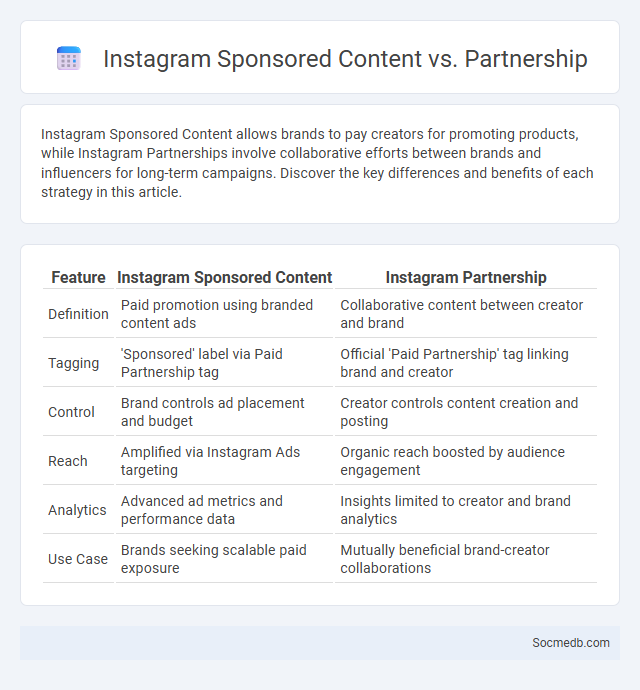
Photo illustration: Instagram Sponsored Content vs Partnership
Instagram Sponsored Content allows brands to pay creators for promoting products, while Instagram Partnerships involve collaborative efforts between brands and influencers for long-term campaigns. Discover the key differences and benefits of each strategy in this article.
Table of Comparison
| Feature | Instagram Sponsored Content | Instagram Partnership |
|---|---|---|
| Definition | Paid promotion using branded content ads | Collaborative content between creator and brand |
| Tagging | 'Sponsored' label via Paid Partnership tag | Official 'Paid Partnership' tag linking brand and creator |
| Control | Brand controls ad placement and budget | Creator controls content creation and posting |
| Reach | Amplified via Instagram Ads targeting | Organic reach boosted by audience engagement |
| Analytics | Advanced ad metrics and performance data | Insights limited to creator and brand analytics |
| Use Case | Brands seeking scalable paid exposure | Mutually beneficial brand-creator collaborations |
Introduction: Understanding Instagram Promotional Collaborations
Instagram promotional collaborations enable brands and influencers to leverage each other's audiences for enhanced visibility and engagement. This marketing strategy involves co-creating content or endorsing products to build trust and authenticity among followers. By utilizing Instagram's collaboration features, users can tag partners directly, expanding reach and driving higher conversion rates.
Defining Instagram Sponsored Content
Instagram Sponsored Content refers to posts or stories created by influencers, brands, or businesses that are paid promotions aiming to reach a targeted audience. This type of content is labeled to ensure transparency, allowing users to recognize advertisements seamlessly integrated within their feed. Understanding how Instagram Sponsored Content works can optimize your marketing strategy for better engagement and brand visibility.
Exploring Instagram Partnerships
Instagram partnerships enhance brand visibility by leveraging influencer collaborations and co-branded content to reach targeted audiences effectively. Strategic use of Instagram's features such as Stories, Reels, and IGTV maximizes engagement and drives higher conversion rates. Analyzing partnership metrics like engagement rates, follower growth, and user interactions helps optimize campaign performance and ROI.
Key Differences: Sponsored Content vs Partnership
Sponsored content involves brands paying influencers or platforms for specific posts that promote products or services, typically marked as advertisements to comply with disclosure regulations. Partnerships represent ongoing collaborations where brands and influencers or creators work together strategically over time to build brand awareness and authentic engagement. While sponsored content is transactional and campaign-based, partnerships aim for sustained influence and deeper brand integration.
Types of Sponsored Content on Instagram
Sponsored content on Instagram includes photo ads, video ads, carousel ads, and story ads designed to promote brands and products effectively. Influencer sponsorships leverage authentic engagement by partnering with popular accounts to reach targeted audiences. Your marketing strategy benefits from utilizing these diverse ad formats to maximize visibility and interaction on the platform.
Partnership Models: Influencers and Brands
Partnership models between influencers and brands leverage social media's vast reach to create authentic content that drives engagement and conversions. Influencers provide personalized endorsements, boosting brand visibility and trust among targeted audiences through platforms like Instagram, TikTok, and YouTube. Brands benefit from data-driven collaborations, using influencer analytics to optimize campaign performance and maximize return on investment.
Disclosure Rules for Sponsored Posts and Partnerships
Social media platforms enforce strict disclosure rules for sponsored posts and partnerships to ensure transparency and maintain user trust. Influencers and brands must clearly label paid collaborations using hashtags like #ad or #sponsored in compliance with FTC guidelines. Failure to disclose can lead to penalties and damage to reputation, emphasizing the importance of honest communication in digital marketing.
Pros and Cons: Sponsored Content vs Partnership
Sponsored content offers brands quick visibility and measurable ROI by targeting specific audiences on social media platforms, making it ideal for driving short-term campaigns. Partnerships, on the other hand, build long-term credibility and deeper audience trust by aligning your brand with influencers or organizations that share similar values. You should weigh the immediate engagement benefits of sponsored content against the sustained brand loyalty that partnerships can foster.
Choosing the Right Approach for Brand Growth
Selecting the ideal social media strategy is crucial for maximizing brand growth and engagement. Analyze your target audience's preferences and behaviors on platforms like Instagram, LinkedIn, and TikTok to create tailored content that resonates. Your consistent and data-driven approach will strengthen brand presence and drive measurable results across social channels.
Conclusion: Maximizing Instagram Marketing Strategies
Maximizing Instagram marketing strategies involves leveraging high-quality visuals, targeted hashtags, and consistent posting schedules to boost engagement and brand visibility. You should analyze insights regularly to refine content based on audience behavior and preferences. Cultivating authentic interactions and utilizing Instagram Stories and Reels can significantly enhance your marketing impact.
 socmedb.com
socmedb.com